The NVIDIA GeForce GTX 1070 Ti Founders Edition Review: GP104 Comes in Threes
by Nate Oh on November 2, 2017 9:00 AM EST- Posted in
- GPUs
- GeForce
- NVIDIA
- Pascal
- GTX 1070 Ti
Overclocking
As NVIDIA is pushing the GTX 1070 Ti for overclocking, it is only fair that we look into it. While NVIDIA does support overclocking, they have limited actual overvolting, and instead providing the ability to unlock 1-2 more boost bins and associated voltages. Using Precision XOC, we adjusted the core and memory clocks, as well as the power/temperature limit and percent 'overvoltage.' For the 180W GTX 1070 Ti, the TDP and TDP limit match the GTX 1080, resulting in a 120% power limit (216W). The 1.093v boost voltage is no surprise, matching the GTX 1080 and 1070 FEs.
| GTX 1070 Ti FE Overclocking | ||||
| Stock | Overclocked | |||
| Core Clock | 1607MHz | 1787MHz | ||
| Boost Clock | 1683MHz | 1863MHz | ||
| Max Boost Clock | 1898MHz | 2078MHz | ||
| Memory Clock | 8Gbps | 8.8Gbps | ||
| Max Voltage | 1.062v | 1.093v | ||
The results, of course, cannot be taken as representative of all GTX 1070 Ti Founders Editions, as this is only a sampled sample size of one. But results here can offer some insight. For one, if there were explicit actual overvolting, it seems very possible to stabilize ~2100+MHz clocks on the GTX 1070 Ti Founders Edition. At any rate, GPU overclocks topped out with observed clocks in the high 2000MHz region, roughly 10% over the previously measured average in-game clockspeeds. Memory overclocks were only able to go up 200MHz from the base 2002MHz, or also about 10%. All-in-all, very similar to the GTX 1070 FE, which also managed 10% overclocks on both GPU and GDDR5 memory. Recalling that the GTX 1070 Ti FE clocked on average just 2% higher than the GTX 1070 FE at stock, there's nothing particularly groundbreaking here, especially considering the 20-25% overclock capability of Maxwell 2 reference cards.
A total of four different overclocks were tested. First was a baseline, consisting of 100% overvoltage and max power/temperature limits. The second was overclocking the GDDR5 memory by 800Mbps. The third was overclocking the GPU with a +180MHz offset; in practice this resulted in observed clocks between 2030 - 2080MHz. Lastly, all previous adjustments were combined for an overall overclock.
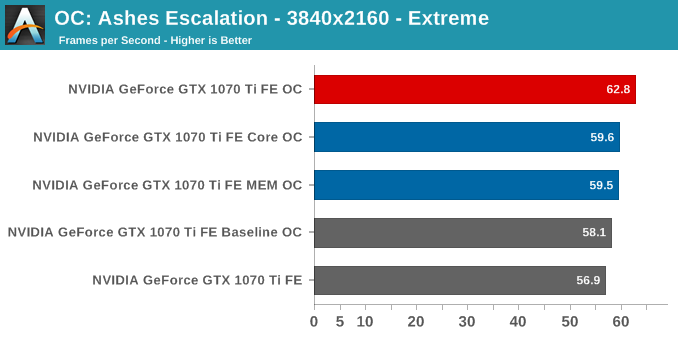
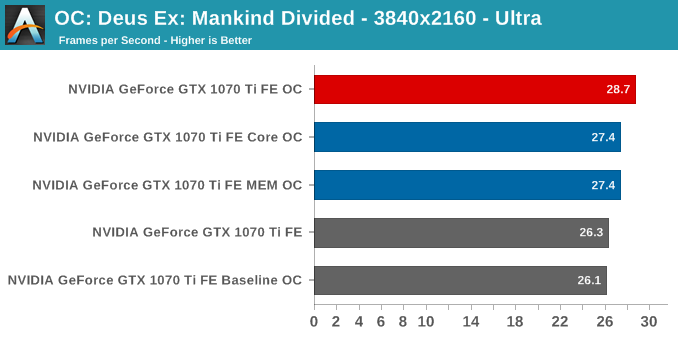
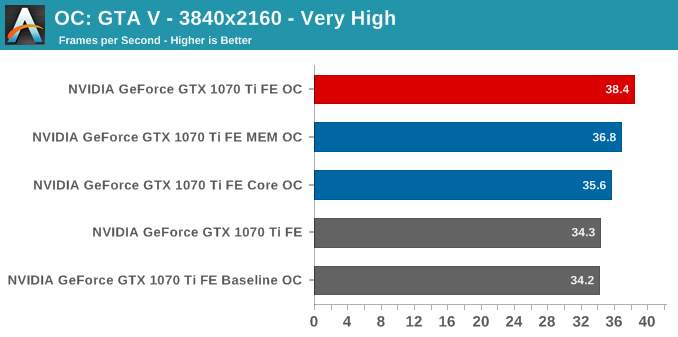
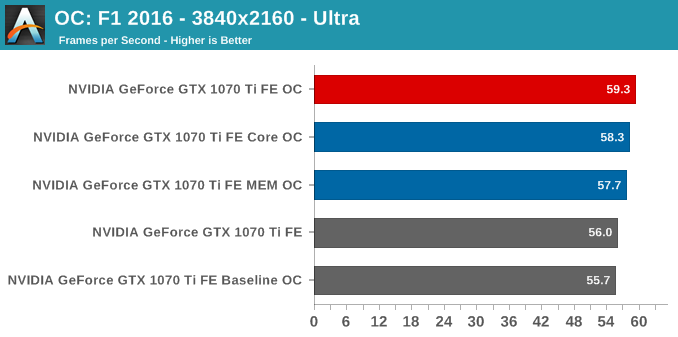
Although this is more of a cursory look than anything else, the combined overclock provides the best performance, just like it was for the GTX 1080 and 1070, although it seems like memory overclocking is more effective on the GTX 1070 Ti. Earlier, we mentioned how the GTX 1070 Ti compared to the GTX 1070 by having four more SMs but without any additional memory bandwidth, and perhaps that is playing a role here.
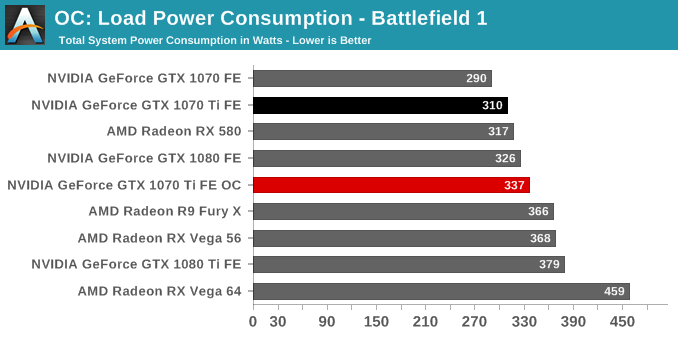
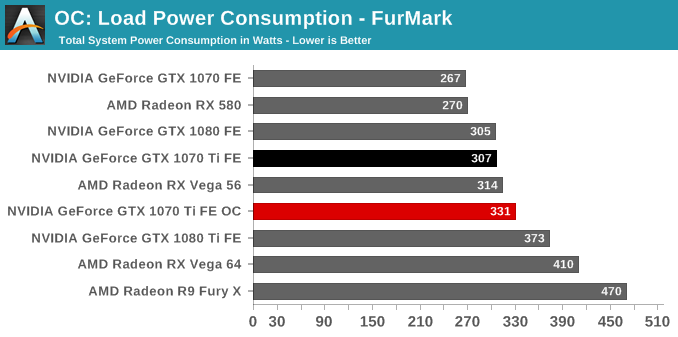
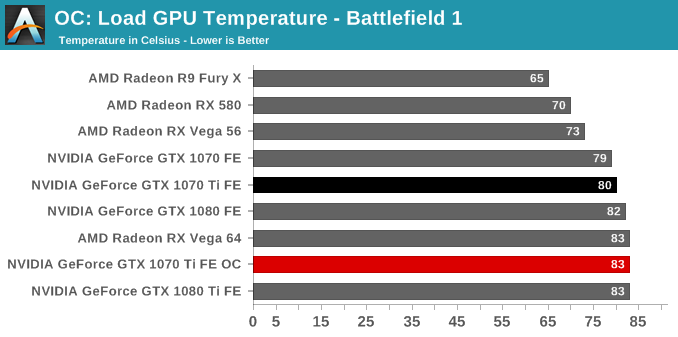
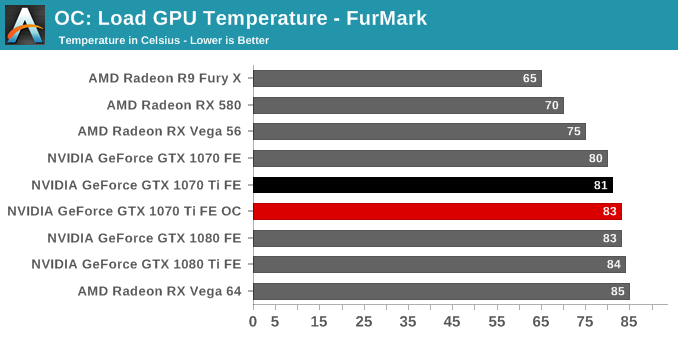
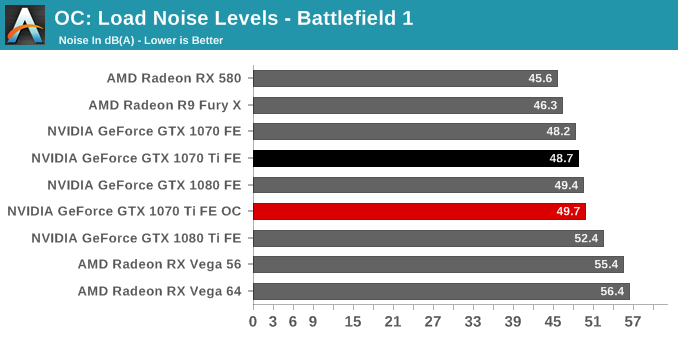
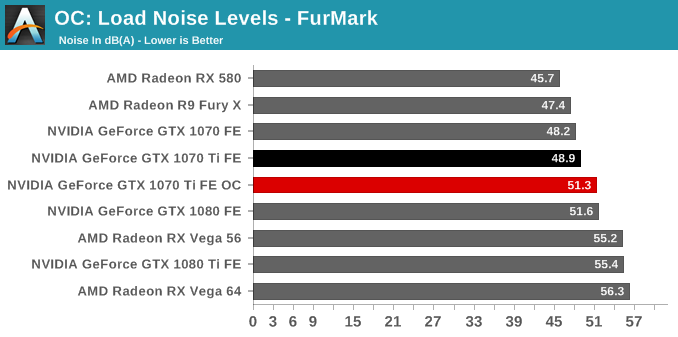
There isn't much to add on the power, temperature, and noise front. Understandably, the card will heat up a few more degrees and spin its blower faster, at the expense of ~25W at the wall, inasmuch as the 120% power limit will let it. As a casual overclocker, there may not be a lot to gain here; the GTX 1070 Ti FE already boosts to ~1800+MHz at stock, and squeezing 200MHz more with the anemic capabilities of NVIDIA's reference PCB won't make waves. And for hardcore overclockers, there would be little need of the reference board's power delivery system.










78 Comments
View All Comments
Bp_968 - Tuesday, December 26, 2017 - link
I know this is an old article but I had to comment on the desktop space being "stagnant". That's mostly true for general consumers and corporate buyers but absolutely not true for med/higher end systems targeted at gamers (and miners). Those two markets are pushing massive demand for high performance desktop CPUs and GPUs (which you can see in AMD and NV's pricing and availability on their GPUs). The year over year performance improvement in CPUs is pretty boring right now but GPUs are still pretty exciting and still seem to have some big leaps left in them. I'm interested in seeing if Intel is going to be able to bring out a capable 3rd option in the discrete GPU space in the next few years. Their track record isn't good so far but having a 3rd player in the GPU/Compute space could really shake things up.I'm with you on the Ryzen APUs. If AMD can manage to make an APU with 1050/1060 level performance that fits in a thin and light notebook that could be a real game changer for many of us. I've mostly given up on gaming laptops because they end up being more of a portable then a mobile system and for most things I do on a laptop I'd just prefer the really thin and light setup. If I can manage to get both thin and light *and* decent gaming performance (even if you need to be plugged in to maintain battery life when gaming) then that would be killer.
The only problem I see is the push for 4k monitors on these little laptops. No APU is going to be able to push 4k anytime soon, but I've never tried gaming at 1080p on a 4k panel and since its still a square pixel at 1080p, it might look fine, in which case it would be a non-issue.
Hxx - Thursday, November 2, 2017 - link
That just makes no sense and heres why. First off, If you're paying over MSRP then you are not paying Intel or Amd or Nvidia or whatever. You are paying that distributor or the retailer or whoever gets those cards from the manufacturer. Second, if the manufacturer quotes an MSRP then this price already covers the costs and whatever the manufacturer wants to charge you for.It has nothing to do with whether or not you can afford it. Thats irrelevant. And if you're wondering WHY the vendor charges over MSRP is because 1) they can, 2) they know the demand is high so they know there are suckers like you who are willing to pay.
"Bullwinkle J Moose" - Thursday, November 2, 2017 - link
Higher prices would destroy AMDTo demand a higher price, they would need to compete with NVidia with cards that ran cooler/quieter, used less power and outperformed NVidia cards for the same price
That's just not happening anytime soon
Hixbot - Thursday, November 2, 2017 - link
The MSRP seems a bit high. The MSRP is a bit irrelevant as miners will push up the price even further.For me, it's a still a good purchase because of the blower cooler which I need for my SFF PC, all other Founder Edition cards are unavailable.
Wwhat - Sunday, November 12, 2017 - link
I think any device relying on Nvidia or AMD drivers/software should reflect that, and they should not dare to sell anything over $500.Samus - Thursday, November 2, 2017 - link
I’m glad I’m not the only one who finds it ridiculous that the mainstream cards are now $100-$150 more than they used to be...These price brackets have just gotten ridiculous. I’d like to go back 15-20 years to when the most expensive cards were $200 (TNT2 Ultra :)
Hxx - Thursday, November 2, 2017 - link
It wasnt like this a year ago. This year we just have a couple phenomenons overlapping and the result is this...a market where the demand is high and supply is low. Maybe next year things will change but this year is not consistent with the past couple years where a videocard would drop significantly in price 6 months after release.BrokenCrayons - Thursday, November 2, 2017 - link
I remember splurging on an original TNT with 16MB of VRAM. It was a Diamond Viper V550, I think...but paying $130 or so for it back then felt like an awful lot. It was passively cooled by a tiny little heatsink, but was among the highest performing video cards at the time. Heh, I did want to shove a pair of Voodoo2s in the system behind it for Glide titles. Anyhow, I think economic inflation can account for some of the cost increase in higher end video cards, but certainly not all of it.webdoctors - Thursday, November 2, 2017 - link
The TNT2 was awesome and the best bang per buck at the time. However, the average price of gas (including state taxes) was $1.14 in 1999.https://www.statista.com/statistics/204740/retail-...
Now its $2.14. The Feds have been printing money so fast its essentially become water and diluted. That's why gas and video cards are going up (its true inflation, not the one fed by propaganda outlets). Unless you switch to using the gold standard where it was $290 in 1999 and now its ~$1500.
https://goldprice.org/gold-price-usa.html
So really if you wanted to buy the TNT2 today, instead of $200 it would be $400+, in short get the gtx1060 6gb and be happy.
RiZad - Monday, November 6, 2017 - link
counting for inflation they are ~1% more expensive. based on the tnt2 ultra that launched at $299 not $199